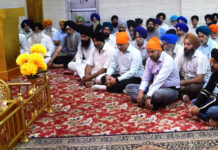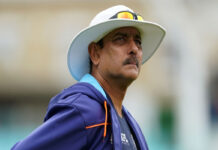NEW DELHI:
On the first day of the third Test, India’s batting finally came together but not without an early alarm. Down at 33 for 3 on a pitch that was full of runs and with two debutants to follow, India were looking at possible trouble. But a 204-run partnership between Rohit Sharma and Ravindra Jadeja for the fourth wicket – India’s first century stand of the series – took them to 326 for 5 at stumps. Rohit and Jadeja got centuries while Sarfaraz Khan made a sparkling debut, hitting 62 off 66, before being run-out.
This was the first time India were playing two debutants in their top seven since their first Test in 1932, and the first time since 1999 they had three players in the top seven who had played fewer than two Tests. That in mind, Mark Wood gave England a leg-up when he got rid of Yashasvi Jaiswal and Shubman Gill – India’s only centurions this series before Thursday- with the new ball. Gill, in particular, got a ball that swung in and then nipped away, that took the outside edge. These two scalps doubled Wood’s tally of wickets in the first six overs of a Test innings.
The early-morning moisture that had assisted Wood possibly helped Tom Hartley grip one in his ninth over, which took the front edge from Rajat Patidar. A day before the Test, Jadeja had said England were not a difficult side to beat. The team management asked him to go out and demonstrate it from No. 5 in the ninth over, the second-earliest he has walked in to bat in a Test innings, and the earliest in the first innings.
A promotion to Jadeja made double sense: protect the debutant Sarfaraz and also introduce a left-hand batter. Coming back from possibly the first time he has missed a Test with a hamstring injury, and having to deal with a family dispute gone public, Jadeja would have been excused for having a lot on his mind when he joined Rohit, but he batted with the most unencumbered mind: just purely reacting to the next ball in an old-school fashion.
Rohit, who had got off to a smashing start, had to do unconventional things at the start of the partnership. Wood tried to bounce him with a fine leg, a deep backward square leg and a deep forward square leg.
For once, looking at the score and the situation, he decided not to hook and had to wear one in his helmet grille.
He charged at James Anderson to cut down the movement, on one occasion chipping one just out of mid-on’s reach. With Hartley, he flicked in the air and against the turn. The first attempt brought four, the second an edge to slip, which Joe Root dropped.
Rohit will argue this was just the luck he needed after the lack of it in the first two Tests. By then, the early movement had begun to die down. Just after that miscued chip off Anderson, Rohit went back to punch him through extra cover for four, an emphatic sign that he was in.
Jadeja never looked less than in. The two took India to lunch without further bother. Just after lunch, Rohit became the 14th man in this series to hit a six. The added responsibility of being the leader of an inexperienced line-up had messed with his approach a little, but now though, we were seeing the usual Rohit. There were timely lofts, some paddle sweeps, and a lot of back-foot runs. His second six took him past MS Dhoni’s 78, with Virender Sehwag as the only Indian ahead of him. Once there was spin from both ends, Jadeja began to catch up too, hitting a six in the final over of the middle session, the first wicketless session of the series. Immediately after tea, Rohit brought up his 11th hundred with two easy couples off two short balls from Rehan Ahmed.
For a long time, the team management would have hoped for the batters to not take risks and just benefit from the inevitable loose balls the inexperienced spin attack was bound to dish up. A little like how Rohit brought up his hundred.
It was happening now with ease, especially for Jadeja. England had to go back to Wood’s pace. A top edge from Jadeja cleared long leg, who was 20 yards in off the fence. Rohit was getting freebies from Rehan. Fifty runs came in 11 overs after tea without having to break a sweat. Then Rohit pulled one off Wood that was probably not short enough to pull. It skidded on, got big on him, and was caught at midwicket.
Out came Sarfaraz with whispers already around his game against quick short-pitched bowling.
That Wood began with a deep fine third, two men deep on the hook, a short leg and a catching forward square leg suggested it was not a mere whisper. Around the wicket he went and looked to bounce Sarfaraz. He ducked the first three nonchalantly. Towards the end of his spell, Wood insisted on one more over. Sarfaraz ducked again before bunting the surprise yorker down the ground.
With pace out of the way, Sarfaraz displayed remarkable skill against spin, helped no doubt by Ben Stokes’ attacking fields. A series of one-twos followed: a loft over the infield followed by going deep into the crease to take a single off the seemingly inevitable shorter delivery. The feet moved perfectly according to the trajectory of the ball, the sweep was out early, and the lofts down the ground were executed perfectly. Before one realised, Sarfaraz had a fifty off 48, the joint second-quickest for an India debutant.
Another byplay had begun to develop. Jadeja had got stuck in the 80s and 90s. In the time that Sarfaraz scored 50, Jadeja had got only 12. He had three hundreds, but four dismissals between 80 and 99. He almost became passive. Had Hartley reviewed his lbw shout against Jadeja, he would have got him out lbw pad-first on 93.
Finally, on 99, Jadeja called Sarfaraz through for an impossible single and unsuccessfully sent him back. Looking at India still leaving the door ajar, Rohit threw his cap in disgust in the dressing room. Jadeja got to the hundred next ball, but the celebrations were subdued since Sarfaraz was gone just one delivery before. Jadeja knew there was more work to do on day two, walking back unbeaten on 110 with Kuldeep Yadav by his side.



























